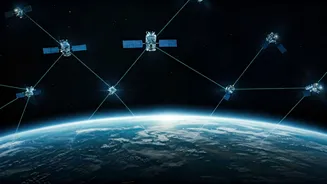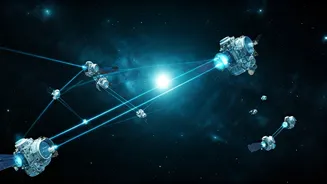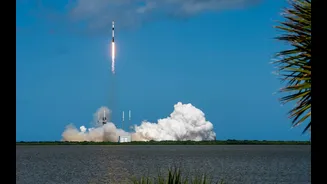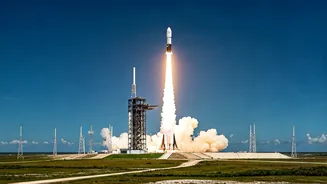Orbit Connectivity Revolution
Muon Space has declared a collaboration with Starlink, which marks a significant shift in how satellites function. This partnership aims to establish a groundbreaking
'persistent optical connectivity in orbit.' This innovative method will transform satellites from isolated systems into dynamic, internet-connected platforms in space. The integration of Starlink's technology will allow these satellites to transmit and receive data constantly, overcoming the limitations of traditional communication satellites which have short periods of connection to ground stations. Muon Space is designing mission-optimized satellite constellations using its Halo platform that will use SpaceX’s Starlink mini laser terminals. The new system will allow link speeds of up to 25 Gbps at distances reaching 4,000 km, giving permanent access to satellite constellations and their data in orbit. This advanced technology promises to reduce data feed latency, bringing it nearly to real-time, thereby creating a dramatic improvement in data transmission capabilities.
Speed and Efficiency Gains
The advantages of this new laser-powered system extend significantly beyond just the continuous availability of data. One of the main benefits is the dramatic reduction in latency. Currently, data feeds can take an average of 20 minutes to process, leading to delays and potential inefficiencies. With the implementation of persistent optical broadband, Muon satellites will experience near real-time data flow. This change in speed is a game-changer for the way space missions are structured. Instead of waiting for data to arrive, users can access it immediately, allowing for quicker decision-making. The improved efficiency is expected to enable mission designers to create new types of space missions that were previously impossible. The ability to collect and analyze data instantly will open doors to various applications, from Earth observation to scientific research. Pascal Stang, CTO of Muon Space, highlighted the transformation, stating that the new system will turn isolated vehicles into active, real-time nodes on Starlink's global network, thereby changing the entire design and workflow of space missions.
Earth Fire Alliance Benefits
The initial user of the new laser-connected communication upgrade will be the non-profit Earth Fire Alliance, highlighting the real-world applications of this technology. Muon will use the advanced technology in its FireSat constellation for purposes like improving wildfire detection and monitoring. By creating 'near-instant alerts of new ignitions', the FireSat system intends to detect and monitor wildfires as soon as they start. The ability to catch fires early can significantly affect the scale of damage, possibly preventing large, catastrophic wildfires. The use of this innovative technology offers a practical solution to enhance early warning systems, thereby assisting in environmental protection. The FireSat example makes it easy to understand the direct impacts of this technology and how it can be used for the benefit of all. The collaboration represents not just a technical breakthrough but also a step toward a better world.
Commercial Implications Explored
Beyond the benefits for the Earth Fire Alliance, the introduction of live, internet-connected platforms in orbit has a wide range of commercial uses. Muon Space emphasizes the possibility of creating 'data center–class pipelines' in space. This infrastructure would enable applications such as in-orbit edge processing, allowing for real-time data fusion, AI inference, and product generation. The implications of this are extensive. Data gathered in space can be processed on-site, reducing the need to transmit raw data to Earth. This reduces delays and costs. Moreover, real-time data processing capabilities will open the door to advanced applications, offering new ways to conduct research. This will also boost the development of innovative products. The introduction of this technology is not only changing the space sector but also the potential for data processing, research, and product development.
Enhanced Security and Uptime
The Starlink / Halo platform provides robust security and reliable performance. Muon asserts that the newly integrated platform will offer 99% uptime, with short handover periods. This high level of availability ensures uninterrupted communication and data transfer. Security is a primary concern in the design of the system. User traffic will be transmitted through Starlink's satellite network in encrypted, mutually authenticated tunnels. Hardware-anchored keys and customer-controlled end-to-end encryption are integrated for multiple layers of protection. This advanced security approach secures data and provides the users with control over their information. The combination of high uptime and comprehensive security measures will be crucial for the adoption of the platform across different sectors. The design places an emphasis on reliable and secure communications, creating an environment where data is safe and available at all times.
Launch Timeline and Outlook
The timeline of the collaboration projects an optimistic outlook for the future of space technology. Mission-optimized satellite constellations firm, Muon Space, is actively integrating Starlink’s mini laser terminals into current customer constellations. The company aims to launch its first Starlink-enabled Halo satellite in Q1 2027. This ambitious launch date shows the speed of progress in the sector. It is a sign of what is expected from the development of this technology. Once launched, these satellites will create a global infrastructure for high-speed, secure, and reliable data transmission. This will redefine space exploration, commercial applications, and scientific research. The combination of technological advancements, strategic partnerships, and a clear vision will make a significant impact on the space landscape.












